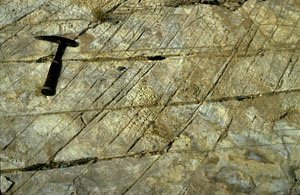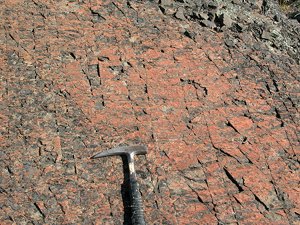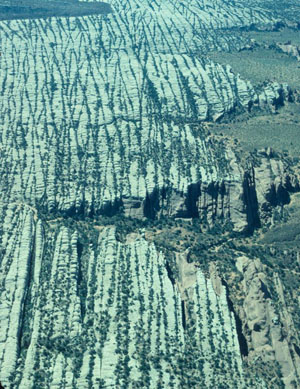|
Non-orthogonal joint sets are composed of two or more joint sets at an oblique angle to each other (Figure 1, Figure 2, and Figure 3). Considering that joints form perpendicular to the greatest tensile principal stresses or the least compressive principal stresses, this pattern cannot be produced during a single loading configuration. Using abutting relationships, it is easy to establish the formation sequence of the sets. Most importantly, during the formation of the younger set, the older joint set must have been subjected to shearing, which is commonly referred to as sheared joint set or sheared joint based fault set.
 | | Figure 1. Photo showing two sets of non-orthogonal joints bounding diamond-shaped blocks in quartzite, Mosaic Canyon, Death Valley, NV. Both sets are partially filled by precipitants. The set paralleling the longer side of the photo is more continuous, while some of the diagonal fractures have truncated ends. The horizontal set is the earlier one and slightly sheared. However, in some other cases the diagonal fractures appear to cut across the older fractures. |
 | | Figure 2. Two sets of fractures on a pavement in siltstone cropping out in Chilean Patagonia. Both sets initially formed in opening mode: one is trending up-and-down with respect to the frame and the other diagonal to the sides. Clearly, the up-and-down trending set is more continuous whereas some members of the diagonal set truncate against the other sets. The intersection angle is about 35 degrees. Chilean Patagonia. From Gonzales and Aydin (2008). |
 | | Figure 3. Aerial view of non-orthogonal joint sets with low intersection angle in the Jurassic Entrada Sandstone cropping out on the NE flank of the Salt Valley Anticline at Arches National Park, Utah. View due down and northwest and the width of the photograph at the bottom is about one kilometer. The white colored rocks belong to the Moab Member of the Entrada Sandstone and the red rocks below are the Slick Rock Member. The systematic set swings gradually from the view direction at the bottom of the photograph to more NW-SE orientation at the top locally tracing the bedding strike. Please see Dyer (1983) and Cruikshank and Aydin (1995) for additional photographs, maps, and diagrams of the joint patterns in Arches National Park. |
The sequence of the formation of joint sets, their distribution, and intersection angles control the resulting geometry of fractures. For the time being, we will note that the fundamental process is splay fracturing and that the angle between the sheared fractures and their splays vary as shown in the examples in Figures 1 to 3.
| |
Cruikshank, K.M., Aydin, A., 1995. Unweaving the joints in Entrada Sandstone, Arches National Park, Utah, U.S.A.. Journal of Structural Geology 17: 409-421.
Dyer, J.R., 1983. Jointing in sandstones, Arches National Park, Utah. Ph. D. Dissertation, Stanford University, 202 p.
Gonzales, J., Aydin, A., 2008. Structural characterization of deep-water deposits in foreland basin, Silla Syncline (Chilean Patagonia), with applications to depositional processes. Journal of Structural Geology 30: 1095-1108, doi:10.1016/j.jsg.2008.05.002.
Rives, T., Petit, J.P., 1990. Experimental study of jointing during cylindrical and non-cylindrical folding. In Rossmanith, H. P. (ed.), Mechanics of jointed and faulted rock, 205-211, A. A. Balkema, Rotterdam.
|


